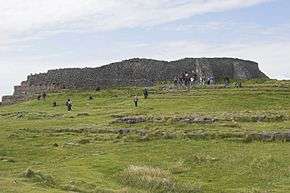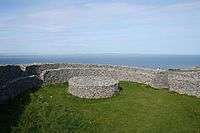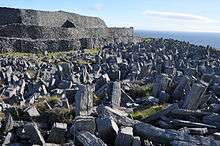Dún Aonghasa
 | |
 Shown within Ireland | |
| Alternate name | Dun Aengus |
|---|---|
| Location | Inishmore |
| Region | Ireland |
| Type | hill fort/promontory fort |
| Area | 6 hectares (outer wall) |
| History | |
| Material | limestone |
| Founded | from 1100 BC |
| Periods | Bronze Age, Iron Age, early medieval |
| Site notes | |
| Public access | yes |
| Reference no. | 23[1] |
Dún Aonghasa (anglicized Dun Aengus)[2] is the most famous of several prehistoric hill forts on the Aran Islands of County Galway, Republic of Ireland. It lies on Inishmore, at the edge of a 100 metre high cliff.
A popular tourist attraction, Dún Aonghasa is an important archaeological site that also offers a spectacular view.
It is not known exactly when Dún Aonghasa was built, though it is now thought that most of the structures date from the Bronze Age and Iron Age.[3] T. F. O'Rahilly surmised in what is known O'Rahilly's historical model that it was built in the second century BC by the Builg following the Laginian conquest of Connacht.[4] Excavations at the site indicate that the first construction goes back to 1100 BC, when the first enclosure was erected by piling rubble against large upright stones. Around 500 BC, the triple wall defences were probably built along the western side of the fort.[5]
The 19th-century artist George Petrie called Dún Aonghasa "the most magnificent barbaric monument in Europe."[6] Its name, meaning "Fort of Aonghas", may refer to the pre-Christian god of the same name described in Irish mythology, or the mythical king, Aonghus mac Úmhór. It has thus traditionally been associated with the Fir Bolg.

Form and function
The fort consists of a series of four concentric walls of dry stone construction, built on a high cliff some one hundred metres above the sea. Surviving stonework is four metres wide at some points. The original shape was presumably oval or D-shaped but parts of the cliff and fort have since collapsed into the sea. Outside the third ring of walls lies a defensive system of stone slabs, known as a cheval de frise, planted in an upright position in the ground and still largely well-preserved. These ruins also feature a huge rectangular stone slab, the function of which is unknown. Impressively large among prehistoric ruins, the outermost wall of Dún Aonghasa encloses an area of approximately 6 hectares (14 acres). Although clearly defensible, the particular location of Dún Aonghusa suggests that its primary purpose was religious and ceremonial rather than military.
Today
The walls of Dún Aonghasa have been rebuilt to a height of 6m and have wall walks, chambers, and flights of stairs. The restoration is easily distinguished from the original construction by the use of mortar.
There is a small museum illustrating the history of the fort and its possible functions. Also in the vicinity is a Neolithic tomb and a small heritage park featuring examples of a traditional thatched cottage and an illegal poteen distillery.
Nearby sites

Dún Dúchathair ("Black Stone Ringfort"), Dún Eoghanachta ("Fort of the Eóganachta"), and Dún Eochla are similar prehistoric sites on Inishmore. Dún Chonchúir ("Fort of Conchobar") is located on nearby Inishmaan.
References
- ↑ National Monuments in County Galway
- ↑ Placenames Database of Ireland
- ↑ New Oxford History of Ireland
- ↑ O'Rahilly, T. F. (1984). Early Irish History and Mythology. Dublin: Dublin Institute for Advanced Studies. ISBN 978-0-901282-29-3.
- ↑ http://heritagecouncil.ie/unpublished_excavations/section11.html
- ↑ George Petrie
External links
| Wikimedia Commons has media related to Dún Aonghasa. |
- Short YouTube video of the Dun Aengus cliff face
- Dun Aengus website
- Dun Aengus page for the Aran Islands website
Coordinates: 53°7′33″N 9°46′5″W / 53.12583°N 9.76806°W
